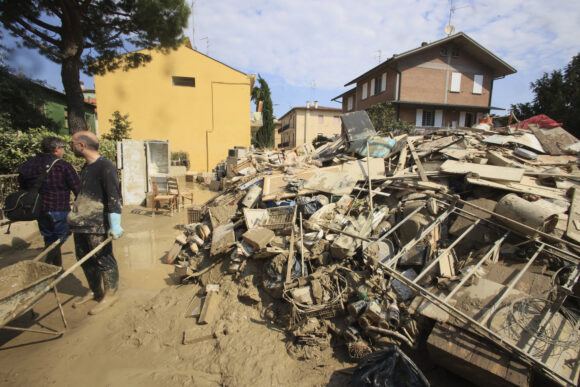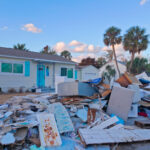Lamberto Mongardi, a farm owner in the northern Italian town of Lugo, was hit twice when torrential rain lashed the area last month: not only was much of his property washed away, but he also discovered his insurance cover excluded damage from floods.
Mongardi’s story is commonplace in Italy and is one reason many people don’t bother insuring their property at all, relying on the state to pick up the tab when disasters strike, with a heavy toll on Rome’s strained public finances.
“I trusted the person who organized my insurance,” Mongardi said, only to find that the lack of protection against floods and earthquakes was hidden in the small print of his contract. He is left wondering what his policy actually covers, he added.
Between 1980 and 2020 only 5% of losses from climate-related catastrophes were insured in Italy, against a European average of 27%, according to the European Central Bank.
“Under-insurance is evident,” said the sector watchdog IVASS, citing bureaucratic complexities, the high cost of cover, and a preponderance of small businesses that prefer to take a risk rather than increase their outlays.
Compensating people hit by Italy’s frequent earthquakes, landslides and floods is a considerable burden for a country with the euro zone’s second-largest debt load, and crimps resources available for other things.
Earthquakes in central Italy in 2009 and 2016 cost public accounts more than 30 billion euros ($33 billion), around 1.7% of national output.
In response to May’s floods in Emilia Romagna that killed 15 people, Prime Minister Giorgia Meloni allotted 1.5 billion euros for the area and topped up a 490-million euro national fund to tackle natural disasters with an additional 200 million.
“We have to overcome the reluctance of firms and families to take out insurance against natural calamities,” said Industry Minister Adolfo Urso. The government is working on financial incentives to encourage it, he added.
In March 2022 just 5% of households were covered against natural disasters, according to insurance association ANIA.
‘Vulnerable to Everything’
Rising temperatures make the problem more urgent.
“Climate-driven catastrophes in Italy will become more frequent and more intense,” said climatologist Luca Mercalli.
“We are vulnerable to everything, from forest fires to melting glaciers on our mountains and rising sea levels along our 8,000 kilometers (5,000 miles) of coastline.”
Massimiliano Giansanti, the head of farmers’ association Confagricoltura, said the group was trying to instill an “insurance culture,” and had lobbied for it to be mandatory for farmers to take out cover in order to obtain European Union subsidies.
“Unfortunately our calls went unheeded,” he said.
Elsewhere in Europe, and even more so in the United States, more private insurance means less burden on the public purse.
In Britain and Spain, for example, house buyers need comprehensive buildings insurance to obtain a mortgage. In France all homeowners must take out a policy.
In 2021 just 10.5% of Italian farmlands were insured, the sector watchdog IVASS said. In the same year the crop coverage level in the United States reached an all-time high of 74%, according to the Department of Agriculture.
Many Italians blame insurance companies, saying miserly payouts are not worth the premiums.
“In 2014 my farmland was hit by floods but I got very little from the insurance, so I decided to cancel my policy,” said Andrea Ferri, a farmer from Imola in Emilia Romagna whose fields were spared by this year’s flooding.
‘Cultural Problem’
Insurers say the growing frequency of climate-related events makes it more complex and expensive to assess risks and costs.
They point out that few people take out cover and those that do are mainly in high-risk situations. This creates a vicious circle of less revenue and more risk for insurers, forcing them to hike premiums, which deters others from insuring.
“In Italy insurance is seen as a tax, especially by small firms,” said Simone Lazzaro, the chief underwriting officer at Verona-based insurer REVO. “It’s a cultural problem.”
Other countries have found their own solutions.
In Britain, where the main natural disaster is flooding, people who live in flood-risk areas in houses built before 2009 get a subsidy on their insurance thanks to a re-insurance scheme called Flood Re, launched in 2016.
The reinsurance is part-funded by a levy on all buildings insurance sold in Britain, which raises 135 million pounds ($172 million) per year.
In Spain, a similar scheme has been in place since 1941 as a backstop for insurers in cases of natural disasters, but only for people who already have a policy of their own.
The fund, which amounts to some 9 billion euros, is financed by a surcharge on each private insurance policy.
Italy’s insurance body ANIA said it hoped to see “the creation of a partnership between the private and public sectors, as we see in many European countries.”
($1 = 0.9140 euros)
($1 = 0.7846 pounds)
(Additional reporting by Gavin Jones, Alvise Armellini, Belen Carreno, David Milliken, Leigh Thomas, Maria Martinez and Elisa Anzolin; editing by Gavin Jones and Mark Potter)
Photograph: Volunteers clear mud as household goods are piled on the side of a street in Faenza, Italy, Monday, May 22, 2023. The Italian government has approved more than 2 billion euros ($2.2 billion) in aid for the flood-stricken region of Emilia-Romagna in the north. Premier Giorgia Meloni said the assistance approved at a cabinet meeting on Tuesday, May 23, 2023 includes suspension of tax and mortgage payments through August for those who suffered flood damage. (Michele Nucci/LaPresse via AP, File)
Topics Natural Disasters
Was this article valuable?
Here are more articles you may enjoy.



 Don’t Forget Tariff Impacts on Workers’ Compensation: Berkley
Don’t Forget Tariff Impacts on Workers’ Compensation: Berkley  Class Action Accuses Toyota of Illegally Sharing Drivers’ Data With Progressive
Class Action Accuses Toyota of Illegally Sharing Drivers’ Data With Progressive  More Floridians Moving Out Due to Housing, Insurance Costs, Cotality Report Says
More Floridians Moving Out Due to Housing, Insurance Costs, Cotality Report Says  Global Q1 Commercial Insurance Rates Drop 3%, but US Casualty Bucks the Trend
Global Q1 Commercial Insurance Rates Drop 3%, but US Casualty Bucks the Trend 

